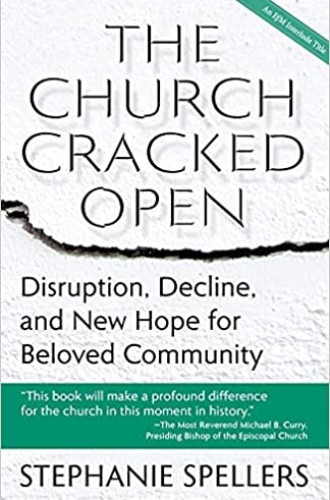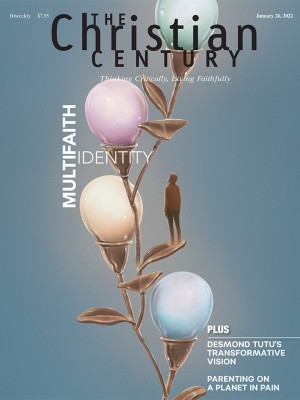Stephanie Spellers’s bold, practical wisdom for American Christians
Kenosis, solidarity, and discipleship
Now is the time, writes Stephanie Spellers, for “individuals, congregations, and entire church bodies to follow Jesus, lose the life bound up with empire and domination, and be reborn as disciples who seek God’s community of love.” Bold and challenging statements like this one characterize the new book by the canon for evangelism and reconciliation to the presiding bishop of the Episcopal Church. The Church Cracked Open is a wake-up call for American Christianity to face the reality that it has not followed Jesus as it should.
Spellers uses the story of the woman breaking open the alabaster jar to anoint Jesus (Luke 7:36–39) to symbolize how the American church has been cracked open by the COVID-19 pandemic and nationwide racial tension. However, she adds, the American church must rethink Christianity before attempting to reassemble what is broken. Supported by facts and facing the truth of her own denomination’s history, Spellers courageously challenges American Christians to have tough conversations surrounding imperialism, racism, and self-centrism. Moreover, she offers solutions that bring us back to what Jesus intended the church to look like and function.
Read our latest issue or browse back issues.
Spellers begins the book by addressing the current realities involving “dominant American Christianity,” which she defines as “the broad community of majority White, mainline Protestant and evangelical churches.” Her precision in defining various Christianities at the outset is essential, because the book’s central theme is the cultural domination of one group over other groups to advance its own interest in a way that is contrary to the reign of God. Spellers uses her own Episcopal denomination as the core example of how American Christians have elevated Whiteness, Eurocentrism, and social class above the loving community Jesus desired for the church to create.
It is worth noting that Spellers does not attack White Christians. She does not accuse every predominately White church of being racist. Rather, she highlights the truth that American churches have historically supported injustices, whether through domination or by staying silent. She provides basic definitions for readers who may not be familiar with her terms, aiming to facilitate open dialogue. For example, she defines Whiteness as “not just having White or light-colored skin or even tracing your ancestry to Europe.” Rather, she explains, “Whiteness is the umbrella that covers, protects, and elevates light-skinned people (and others it chooses to absorb) while leaving non-White people vulnerable to violence, subjugation, and exploitation.” This definition means that culture or thought viewed through a White European lens is, in general, considered superior.
Although American Christianity has recently focused on creating more diverse and multiethnic congregations, leadership has not changed much. The standard for theological thought remains with Europeans like Luther, Calvin, and Wesley. Nevertheless, Spellers believes, God’s grace continues to multiply. Amid disruption and decline, hope for reconciliation and a stronger community is alive and well. To help lead Christians into the beloved community, Spellers outlines three concepts for the church to embrace: kenosis, solidarity, and discipleship.
Rooted in love and modeled after Jesus the Christ, “kenosis is basically the act of emptying oneself” like the community in Acts does. Upon hearing Peter preach the gospel, the people devote themselves to the apostle’s teaching, fellowship, and prayer (Acts 2). They give to one another so that no one will go without, and some are even inspired to sell their possessions. These are individuals from different ethnic backgrounds, cultures, and languages; still, they share one love for Christ and each other. Spellers notes that the “kenotic path assumes we give something of ourselves away—some privilege, some piece of ego . . . to honor, love, and sacrifice for the sake of the God we recognize in one another and in all of creation.”
Once American Christianity is on the road of kenosis, it can embrace solidarity, which Spellers defines as “love crossing the borders drawn by self-centrism . . . for the purpose of mutual relationship.” Solidarity recognizes the differences between you and me but does not allow those differences to hinder the love we should give to one another. Solidarity does not ignore the fact that I may not understand your struggle. Still, I will stand with you for justice, righteousness, or peace.
This is one of my favorite chapters of the book because Spellers transforms solidarity from an abstract idea into a concrete, practical movement we should all embrace. For example, she includes a grid that lays out ways to steward or manage the privilege God has given most of us who live in America. Solidarity challenges us to step into someone else’s shoes so we may gain a different perspective. And from that perspective, we can genuinely share the love of Christ with one another to show that we are Jesus’ disciples.
The final concept, discipleship, should not be foreign to Christians. Still, Spellers wisely challenges readers to start with themselves before looking toward anyone else. American Christians must be willing to become uncomfortable, get out of our bubbles, and model our lives to be more like Jesus. This means that instead of attempting to restore the broken pieces of the church to their former glory, we need to be “reborn as disciples who seek God’s community of love.” Christianity is about unity under Jesus, who did not allow either his divinity or his earthly ethnicity to stop him from preaching the gospel and doing good on earth.
I highly recommend The Church Cracked Open for its relevance, readability, and practicality. Without a doubt, it will drive readers to self-reflection. Still, it will be up to each reader to decide whether to try to grow into the disciple Jesus calls them to be. Spellers reminds us that the beloved community formed in the book of Acts was not a fairy tale. They were real people who genuinely desired to be one in Christ, living in a beloved community. Do we share the same desire?







